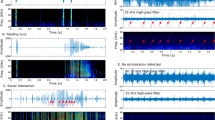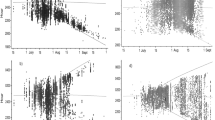Summary
The acoustic behavior of four species of Vespertilionid bats flying in the field was studied using high speed tape recorders and ultrasonic detectors. The bats can be identified solely on the basis of their cries when using a ‘divide-by-ten’ detector. Three species (Eptesicus serotinus, Nyctalus noctula, andPipistrellus pipistrellus) show considerable flexibility in their acoustic behavior, whileMyotis daubentoni has a stereotyped acoustic behavior under our study conditions. Several aspects of the cry repertoire can be correlated with the bats' activities and acoustic environment. During aerial chases and when circling the roost,E. serotinus, N. noctula andP. pipistrellus emit ultrasound that is distinctly different from their orientational cries. Such ultrasound may have a social function.
Similar content being viewed by others
Abbreviations
- FM :
-
frequency modulation
- CF :
-
constant frequency
References
Andersen BA, Miller LA (1977) A portable ultrasonic detection system for recording bat cries in the field. J Mammal 58:226–229
Barclay RMR, Fenton MB, Thomas DW (1979) Social behavior of the little brown bat,Myotis lucifugus. II. Vocal communication. Behav Ecol Sociobiol 6:137–146
Fenton MB (1980) Adaptiveness and ecology of echolocation in terrestrial (aerial) systems. In: Busnell R-G, Fish JF (eds) Animal sonar systems. Plenum Press, New York, pp 427–446
Griffin DR (1958) Listening in the dark. Yale Univ Press, New Haven
Grinnell AD, Hagiwara S (1972) Adaptations of the auditory nervous system for echolocation. Studies of New Guinea bats. Z Vergl Physiol 76:41–81
Ostwald J (1980) The functional organisation of the primary auditory cortex in the CF-FM batRhinolophus ferrumequinum. In: Busnell R-G, Fish JF (eds) Animal sonar systems. Plenum Press, New York, pp 953–955
Pye JD (1972) Bimodal distribution of constant frequencies in some hipposiderid bats. J Zool (Lond) 166:323–335
Pye JD (1973) Echolocation by constant frequency in bats. Period Biol 75:21–26
Pye JD (1980) Echolocation signals and echoes in air. In: Busnell R-G, Fish JF (eds) Animal sonar systems. Plenum Press, New York, pp 309–353
Sales G, Pye JD (1974) Ultrasonic communication by animals. Chapman and Hall, London
Schnitzler H-U (1978) Die Detektion von Bewegungen durch Echoortung bei Fledermäusen. Verh Dtsch Zool Ges 16–33
Schnitzler H-U, Henson OW (1980) Performance of airborne animal sonar systems: I. Microchiroptera. In: Busnell R-G, Fish JF (eds) Animal sonar systems. Plenum Press, New York, pp 109–181
Simmons JA, O'Farrell MJ (1977) Echolocation by the longeared bat,Plecotus phyllotis. J Comp Physiol 122:201–214
Simmons JA, Lavender WA, Lavender BA, Childs JE, Hulebak K, Rigden MR, Sherman J, Woolman B, O'Farrell MJ (1978a) Echolocation by free-tailed bats (Tadarida). J Comp Physiol 125:291–299
Simmons JA, Lavender WA, Lavender BA (1978b) Adaptation of echolocation to environmental noise by the batEptesicus fuscus. Kenya Nat Acad 97–104
Simmons JA, Fenton MB, O'Farrell MJ (1979a) Echolocation and pursuit of prey by bats. Science 203:16–21
Simmons JA, Fenton MB, Ferguson WR, Jutting M, Palin J (1979b) Apparatus for research on animal ultrasonic signals. R Ont Mus Life Sci Misc Publ
Simmons JA, Stein RA (1980) Acoustic imaging in bat sonar: Echolocation signals and the evolution of echolocation. J Comp Physiol 135:61–84
Suga N (1973) Feature extraction in the auditory system of bats. In: Møller AR (ed) Basic mechanisms in hearing. Academic Press, New York, pp 675–744
Suthers RA (1965) Acoustic orientation by fish-catching bats. J Exp Zool 158:319–347
Author information
Authors and Affiliations
Additional information
We wish to acknowledge support from the Danish Natural Science Research Council. We extend our thanks to the estate owners for their kind cooperation. The sound spectrograms in Fig. 6 were kindly provided by Ingemar Ahlén, Swedish University of Agricultural Sciences, Uppsala, Sweden. We thank Axel Michelsen, James A. Simmons, and Bertel Møhl for comments on the manuscript.
Rights and permissions
About this article
Cite this article
Miller, L.A., Degn, H.J. The acoustic behavior of four species of vespertilionid bats studied in the field. J. Comp. Physiol. 142, 67–74 (1981). https://doi.org/10.1007/BF00605477
Accepted:
Issue Date:
DOI: https://doi.org/10.1007/BF00605477




